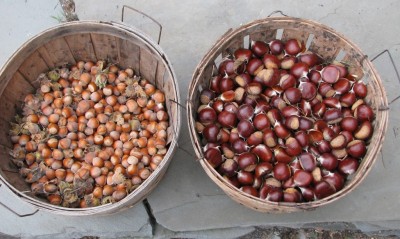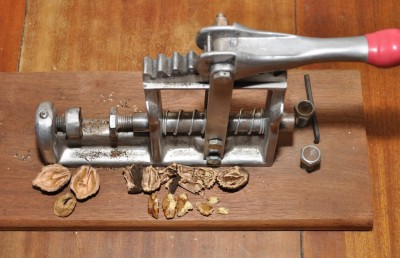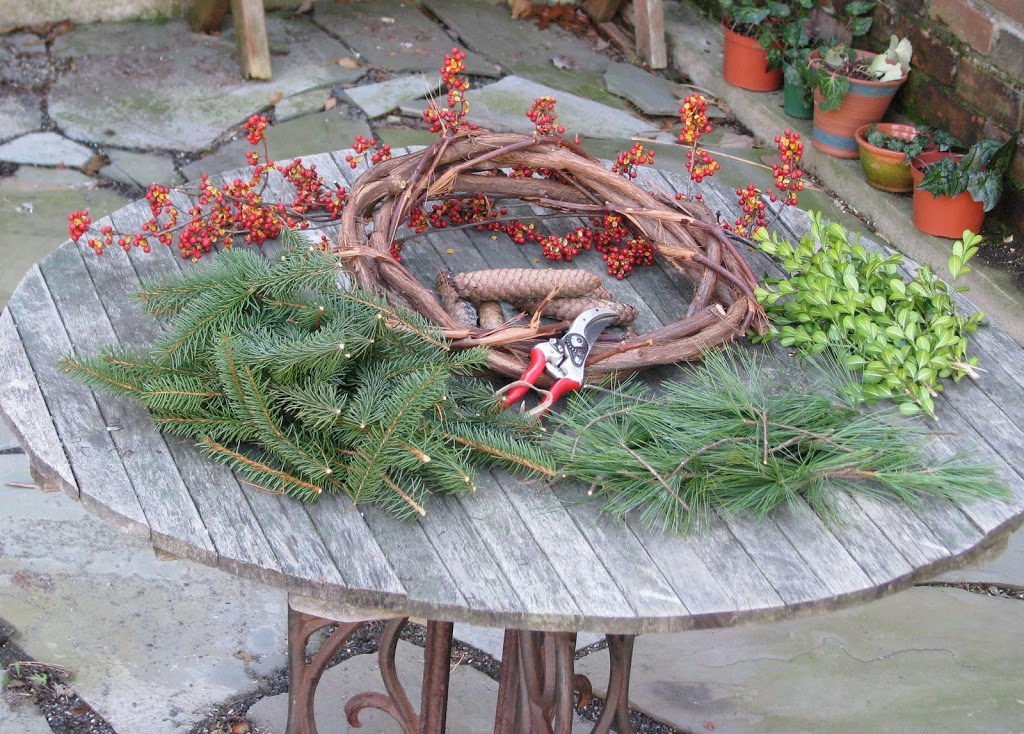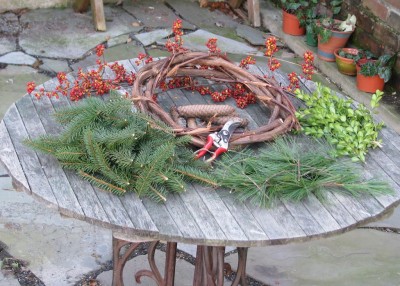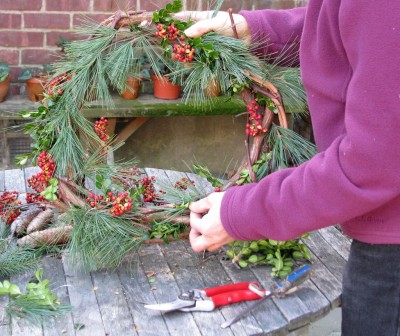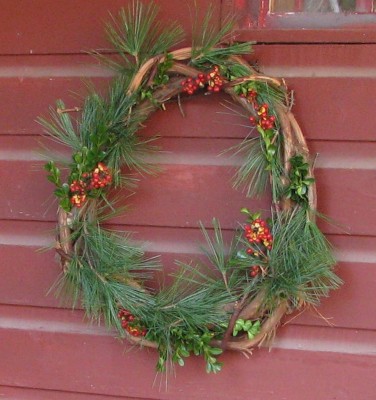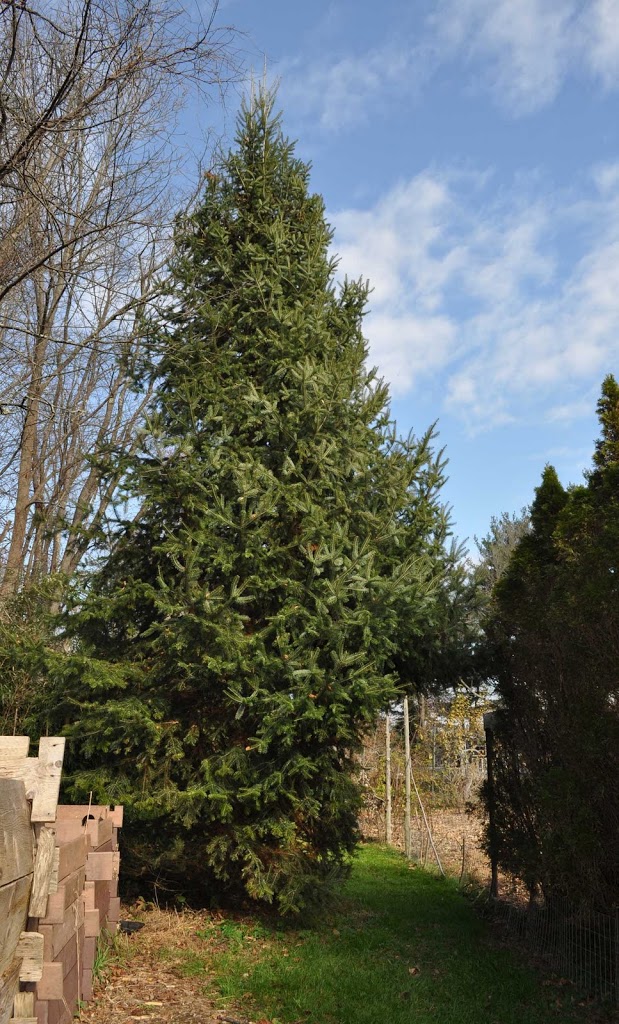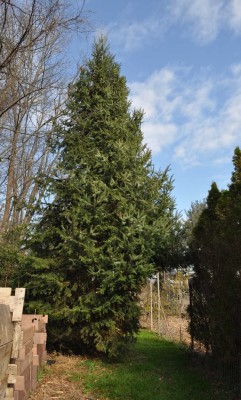WHOSE NUTS?
/4 Comments/in Gardening/by Lee A. ReichNuts are underrated as a food and in the garden. After all, how many gardeners plant nuts? In the landscape, nut plants range from majestic trees to graceful shrubs. As a food, nuts are an excellent source of protein, heart-friendly fats, and all sorts of other nutritional goodies known and unknown. Did you ever see a fat or tired squirrel? (True, we wouldn’t see those couch potato squirrels as they lounged in their den.)
Right now, I am enjoying the fruits of my nutty labors. Some nuts — most nuts that grow around here, in fact — need to be cured before they taste their best. Hazelnuts, ready in September, were good as soon as harvested but even better after resting a couple of weeks. Chestnuts, likewise ready in September, were likewise pretty good immediately, but sweetened after a few weeks in storage. The hazelnuts grow on arching shrubs that could instead be trained to small trees. The chestnuts are picturesque, spreading trees. Both hazelnuts and chestnuts are fast-growing and begin to bear within 5 years or less after planting.
The improvement in flavor from curing is dramatic when it comes to black walnuts and their kin. They were harvested (from the ground) in October, hulled (a messy job), and left outdoors in the sun a few days to dry before being moved to a loft area above the garage. The loft area was cool, airy, and — very important — squirrel-proof. Now they are ready to crack and eat.
—————————————-
Black walnuts are, in my opinion, the best-tasting of the nutty lot. And the trees grow wild throughout much of eastern U.S. This is one nut that I have not planted because I inherited a large tree right on my property. Over the years, new trees have also sprung up to bear nuts. Growth is fast and the trees become quite large. The downside to growing black walnuts for eating is that they are a hard nut to crack. After years of banged thumbs from cracking black walnuts on a concrete floor with a hammer, I purchased the Master Nutcracker, which is elegantly designed, somewhat pricey, but very effective. Separating the nutmeats and picking them out from their cracked shells makes for a convivial accompaniment to after-dinner conversation in winter.
Butternuts, also native to eastern U.S., but not as widespread and currently threatened with a blight, need the same treatment as black walnut and are equally tough nuts to crack. I don’t bother with them because the trees, in contrast to black walnut, are hard to find. Their flavor also has less appeal.
Butternut has naturally and been deliberately hybridized with heartnut, a Japanese-type walnut, to yield what’s known as a buartnut. Many trees thought to be butternuts are actually buartnuts, such as the gigantic, spreading tree I “discovered” in Rosendale a couple of years ago. My young tree, only a few years old, is very fast growing and already shows inklings of future grandeur — and nuts, in the form a few flowers last spring (that, unfortunately, failed to develop into nuts).
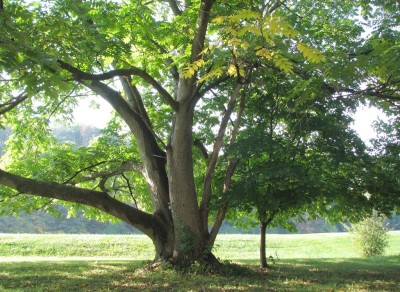 |
| Here’s the Rosendale tree in summer. |
I did revisit the Rosendale buartnut in September and rushed to gather up as many nuts as I could ahead of squirrels, who were also working the tree. Those nuts are now cured. Heartnuts are known for their ease of cracking, a trait also borne out in the buartnut offspring. With the Master Nutcracker, the shells popped open to reveal whole nutmeats. The flavor was mild and a little dry, good for variety and ease of access but not nearly as tasty as black walnuts.
The nut menu needn’t end there. The season here is too short to ripen pecan nuts, although the trees will survive. Enter hicans, hybrids of hickory and pecan with a shorter ripening season. I’ll report back in a few years. Hickories are a native nut that is delicious although small, hard to crack, and yielding little nutmeat. Still, there are some named varieties that improve in all respects. I planted two in the spring of 2011 and hope for some nuts to try within five years. I also have some young Persian walnut trees, the one nut among this bowl of nuts for which I am not hopeful. Persian walnuts blossom early, so the flowers often succumb to subsequent spring frosts, are susceptible to some serious diseases, and — mine, at least — are on a squirrel highway (beneath power lines).
—————————————————-
Have I been mentioning squirrels? Ah, squirrels, once the bane of my nutty endeavors. In years past, these “tree rats,” as they are sometimes nonaffectionately referred to by gardeners, have stripped my hazelnut shrubs bare.
For now, I have the creatures under control. They won’t wander into the high grass that I let rise up through the summer around the hazelnuts. Chestnut burrs are too spiny for them — until the nuts drop out, by which time I’ve gathered them up. My hickories and buartnuts have not yet begun to bear, but the trees are isolated so a temporary squirrel guard of a cylinder of sheet metal should keep the squirrels from climbing. And black walnuts? There are plenty for everyone. The squirrels and I gather them and I still see plenty left on the ground.
HOMEGROWN WREATH
/0 Comments/in Gardening/by Lee A. ReichThe dark green wreath was tied with red ribbons and gliding towards me, in its progress stirring up snowflakes gently floating out of the grey sky. No, the wreath was not hanging from a horse-drawn sled, but was plowing through the frigid air affixed to the chrome grille of a gleaming white Cadillac! Here we are in the twenty-first century, still infusing a breath of life into our winters with cut evergreen boughs, just as did the ancient Egyptians, Persians, Jews, Christians, and Druids.
And it’s true: a few evergreen boughs tied together and accented with a red ribbon do make a doorway more inviting, or a room more cozy in winter. (I’m still undecided about what greenery does for a Cadillac grill.) But going one step further with the greenery, to a bona fide wreath, creates something special. And the actual making of a wreath can be an end in itself this time of year, particularly to the accompaniment of a warm fire and friends and children.
To make a wreath, start with a base. The base might be a sturdy ring of wire (from a coat hanger, for example), or straw that has been bound into a bulky circle with string. Either of these bases can be made from scratch or purchased. For a more natural base, one which might be part of the final design, use a vine such as grape, honeysuckle, wisteria, or bower actinidia. Weave the vine into a circle of triple thickness, tucking in a new piece of vine as an old one ends.
The base might be all, or just about all, that is needed for a simple wreath. I have seen a very attractive wreath that was nothing more than a thick ring of wild rose sprigs showing off a profusion of pastel red fruits. Carefully overlapped sprigs of lavender or rosemary, bound with thin wire to a heavier wire frame, make a dainty, fragrant, blue-green wreath. Thyme is another good plant for this purpose, also fragrant. Keep thyme’s wiry stems somewhat loose, though, because they are as important in adding body to the wreath as are the tiny leaves.
This time of year my penchant is for wreaths that are rich green in color, and almost gaudy with ornamentation. The base for such wreaths is some evergreen plant. Not all evergreens are suitable, because some drop their leaves too readily indoors (and in the brisk wind riding on the front of a car!). Amongst needle-leaf evergreens, juniper, white pine, mugho pine, red pine, and spruce are good choices. Or, for something brighter, needled evergreens with yellow-tipped leaves, such as Gold Star and Kuriwao Sunburst junipers. Mahonia, holly, leucothoe, rhododendron, boxwood, lingonberry, and English ivy are suitable broad-leaf evergreens for a wreath, but none of the broadleaf evergreens will hold their leaves indoors as long as the needle-leaved evergreens.
Wire, glue or tuck small bunches of evergreens onto the base, with all the bunches facing the same direction. Don’t be stingy, because this mass of green color is what is going to calm down and visually hold together the whole wreath.
Next, add accent. Ornaments that are darker shades, and blue or green, make a quieter wreath than ornaments that are lighter shades, and red or yellow. As I said, this time of year I prefer spirited ornamentation, perhaps due to the impending dead of winter. Lively ornaments might include chains of shiny red cranberries or popcorn threaded together, bunches of bright red peppers and garlic clove.
Fruits, like evergreen leaves, flaunt winter’s cold darkness to celebrate the continuity of life from one year to the next. Some brightly colored fruits still clinging to vines and shrubs include mountainash, bittersweet, winterberry, barberry, and, of course, holly. Deck the halls.
XMAS TREE PLANTATION ON MINI-PLOT
/1 Comment/in Gardening, Planning/by Lee A. ReichA living Christmas tree seems the “right” thing to do: You get a holiday tree decorating your living room for a couple weeks; the planet gets a tree to soak up carbon dioxide, provide a playground for wildlife, and contribute to the landscape greenery. The problem is that yearly planting out of living Christmas trees in most yards pretty soon leads to a small-scale version of the Black Forest. A lugubrious and mysterious landscape is not for everyone.
But there is a way to enjoy living Christmas trees, and keep the scene sunny and winsome: Plant very young trees, then harvest them when they reach the size to cut for Christmas. Essentially, have your own tree farm. The tree lives — and you enjoy it as such — until you cut it.
You may imagine that a tree farm big enough to supply you with one tree a year would take up too much space. Not so. A Christmas tree needs about eight years to grow to a harvestable size of about six feet tall. If you have enough space for eight trees, you can cut one and plant a new one every year, for an endless supply. At five foot spacing, all you need is about 200 square feet of area — perhaps a forty foot row, perhaps a rectangular plot ten by twenty feet. This spacing gives each plant enough sun to grow into a well-shaped tree, and allows you plenty of room to mow around each tree. If you prefer smaller Christmas trees, you can plant even closer.
Your tree farm need not be in an out-of-the-way place. A row of trees might make a nice, evergreen hedge. With the wide spacing and variation in tree sizes, the hedge will be somewhat informal. But at least you do not have to worry about the hedge becoming too tall, because trees get removed as soon as they are about head height. The trees also might make a nice screen for your compost bin or dog’s house. How about a miniature forest for your child?
Growing your own trees gives you the option of choosing whatever type of Christmas tree you want. Most commonly cut nowadays for Christmas trees is Scotch pine, a tree that is very cold-hardy, fast growing, and tolerant of many different soil types. And, the plant holds its needles very well indoors.
———————————————-
Scotch pine has been popular only since the 1930s, and over the years many other species have been in favor. In the middle of the 19th century, cedar was a favorite. But it dropped its needles too easily indoors. Then hemlock, one of the fastest growing evergreens, became popular. Its main defect is that its flexible branches bow too far to the ground under the weight of ornaments. Nowadays it’s also beset by a serious insect pest, the woolly adelgid. By the end of the 19th century, balsam fir became popular. This tree, still popular for Christmas in New England, makes up for its deficiencies — slow growth, less than ideal shape, and some needle drop — with its woodsy aroma that is rightly reminiscent of northern or mountaintop forests.
If you grow balsam fir — and I planted a half-dozen of them almost 20 years ago — make sure to give it a cool, moist soil. The climate around here is warmer than usually enjoyed by balsam fir, but I figured that the fragrance made balsam fir worth a try. My dog Stick, then a leashed puppy, soon chewed up 5 of my young trees, which were all that he could reach when he was young and leashed. One survived, and the survivor is now a towering, fragrant beauty about 25 feet tall and so wide that I had to cut an opening in its lower limbs to allow passage past it along the back portion of the garden.
I never could bring myself to cut that sole survivor to bring indoors for the holidays. The tree is so kind as to keep making two leading stems. Cutting one of them lets the other grow and gives me a manageable holiday tree that leaves the remaining tree healthier. If both leading stems were allowed to grow, they would be apt to split apart at their origin.
———————————————————–
Nowadays, besides Scotch pine, other popular Christmas trees include eastern white pine, Norway spruce, white and Colorado spruces, Douglas fir, and Fraser fir. White pine is fast growing, with an open form that you may or may not prefer in a Christmas tree. This native plant tolerates almost any soil, and even a bit of shade. Norway spruce is almost as fast growing, and is a graceful tree with arching limbs along the bottoms of which dangle short, needled branchlets. Norway spruce needs well-drained soil and full sun.
White and Colorado spruce, and Douglas and Fraser firs, are slow-growing trees. (The two firs are unrelated: Douglas is Pseudotsuga menziesii; Fraser is Abies fraserii.) The two spruces require moist, yet well-drained soil, in full sun. Douglas fir needs full sunlight, but cannot tolerate a windy site or dry soil. Douglas fir holds its needles indoors almost as well as does Scotch pine. Fraser fir needs wet soils in full sun or part shade.
A miniature tree farm requires very little time for maintenance. A thick mulch of straw or leaves will conserve soil moisture and smother weeds. Grow grass between the trees and mow it regularly to prevent competition for nutrients and moisture, especially when the trees are very small. If you prefer a tighter growth habit to your trees, and have the time and inclination, prune them once a year, shortening by half the “candles” of new growth before they expand in early summer. And finally, keep teething, playful puppies at bay from any trees for their first couple of years.


